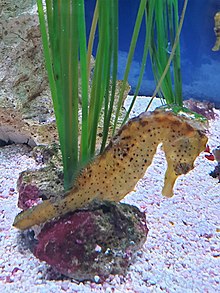
A seahorse is any of 46 species of small marine bony fish in the genus Hippocampus. "Hippocampus" comes from the Ancient Greek hippókampos (ἱππόκαμπος), itself from híppos (ἵππος) meaning "horse" and kámpos (κάμπος) meaning "sea monster" or "sea animal". Having a head and neck suggestive of a horse, seahorses also feature segmented bony armour, an upright posture and a curled prehensile tail. Along with the pipefishes and seadragons they form the family Syngnathidae.

The big-belly seahorse or pot-bellied seahorse is one of the largest seahorse species in the world, with a length of up to 35 cm (14 in), and is the largest in Australia. Seahorses are members of the family Syngnathidae, and are teleost fishes. They are found in southeast Australia and New Zealand, and are listed on Appendix II of CITES. They are the only species of seahorse found in New Zealand, with a habitat range spanning from the Three Kings Island in the north all the way to the Snares Island in the south.

Barbour's seahorse is a species of fish of the family Syngnathidae.

The knobby seahorse, also known as the short-headed seahorse or short-snouted seahorse, is a species of marine fish of the family Syngnathidae. It inhabits coastal waters in southwestern and southeastern Australia, from Gregory to Bremer Bay, and from Denial Bay to Newcastle.

The Knysna seahorse or Cape seahorse is a species of fish in the family Syngnathidae. It is endemic to the south coast of South Africa, where it has been found in only three brackish water habitats: the estuary of the Keurbooms River in Plettenberg Bay, the Knysna Lagoon, and the estuarine portion of the Swartvlei system in Sedgefield. The limited range of this seahorse puts it at great risk of extinction.

The tiger tail seahorse is a species of fish in the family Syngnathidae. The species was first described by Theodore Cantor in 1850. It is found in India, Indonesia, Malaysia, the Philippines, Singapore, Thailand and Vietnam. Its natural habitats are subtidal aquatic beds and coral reefs. It is threatened by habitat loss.

Hippocampus guttulatus, commonly known as the long-snouted seahorse and in Great Britain as the spiny seahorse, is a marine fish belonging to the family Syngnathidae, native from the northeast Atlantic, including the Mediterranean.

The Pacific seahorse, also known as the giant seahorse, is a species of fish in the family Syngnathidae. Their genus name (Hippocampus) is derived from the Greek word hippos, which means "horse" and campus, which means "sea monster." This species is the only seahorse species found in the eastern Pacific Ocean.
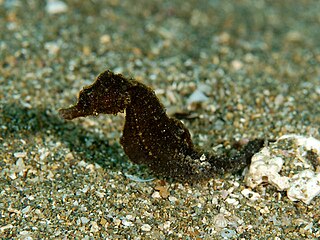
The Japanese seahorse or lemur-tail seahorse is a species of fish in the family Syngnathidae. The Japanese seahorse reaches a maximum length of 8.0 cm, is usually dark brown and has a relatively long tail, a ridgelike coronet and flattened spines. Many seahorse species look similar, so in addition to any distinguishing features, individual specimens are identified using a series of specific measurements and counts of anatomical features such as spines and tail rings.

The hedgehog seahorse is a species of fish of the family Syngnathidae. It inhabits coastal waters from India and Sri Lanka to Taiwan and northern Australia. It is threatened by overfishing, as both targeted catch and bycatch. This species is ovoviviparous, with males carrying eggs in a brood pouch before giving birth to live young.
The false-eye seahorse, or flatface seahorse is a species of marine fish of the family Syngnathidae. It is endemic to Australia, from Shark Bay to Broome, where it is found in intertidal rockpools, shallow algae and weedy or rubble reef habitats. It is expected to feed on harpacticoid, calanoid, and cyclopoid copepods, caridean and gammaridean shrimps, and mysids, similar to other seahorses. This species is ovoviviparous, with males brooding eggs in a brood pouch before giving birth to live young.

Hippocampus whitei, commonly known as White's seahorse, New Holland seahorse, or Sydney seahorse, is a species of marine fish of the family Syngnathidae. It is thought to be endemic to the Southwest Pacific, from Sydney, New South Wales and southern Queensland (Australia) to the Solomon Islands. It lives in shallow, inshore habitats, both natural and anthropogenic. This species is ovoviviparous, with males brooding eggs in a brood pouch before giving birth to live young.
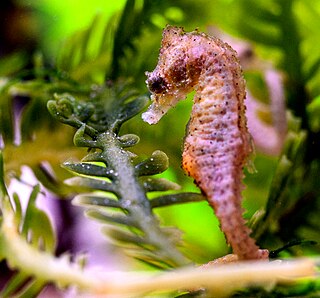
The dwarf seahorse is a species of seahorse found in the subtidal aquatic beds of the Bahamas and parts of the United States. It is threatened by habitat loss. According to Guinness World Records, it is the slowest-moving fish, with a top speed of about 5 feet (1.5 m) per hour.

The short-snouted seahorse is a species of seahorse in the family Syngnathidae. It is endemic to the Mediterranean Sea and parts of the North Atlantic, particularly around Italy and the Canary Islands. In 2007, colonies of the species were discovered in the River Thames around London and Southend-on-Sea.
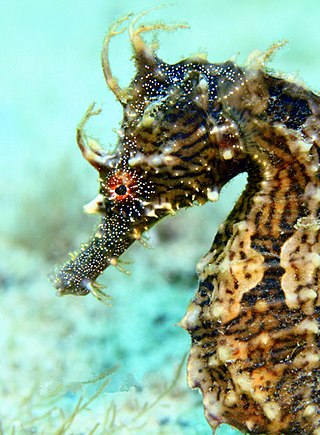
The lined seahorse, northern seahorse or spotted seahorse, is a species of fish that belongs to the family Syngnathidae. H. erectus is a diurnal species with an approximate length of 15 cm and lifespan of one to four years. The H. erectus species can be found in myriad colors, from greys and blacks to reds, greens, and oranges. The lined seahorse lives in the western Atlantic Ocean as far north as Canada and as far south as the Caribbean, Mexico, and Venezuela. It swims in an erect position and uses its dorsal and pectoral fins for guidance while swimming.

The spiny seahorse, also referred to as the thorny seahorse, is a small marine fish in the family Syngnathidae, native to the Indo-Pacific area. It is classified as a Vulnerable species by the IUCN.

Hippocampus pontohi, also known as Pontoh's pygmy seahorse or the weedy pygmy seahorse, is a seahorse of the family Syngnathidae native to the central Indo-pacific. Named after Hentje Pontoh, the Indonesian dive guide from Bunaken (Manado) who first brought these pygmy seahorses to attention.
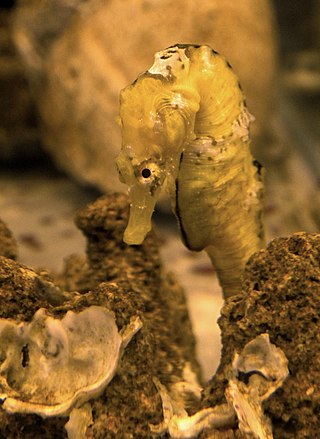
The Patagonian seahorse is a species of marine fish of the family Syngnathidae. It inhabits coastal waters from northeastern Brazil to Chubut, Argentina. It generally is found at shallow depths attached to natural or artificial substrates. This species is ovoviviparous, with males brooding eggs in a brood pouch before giving birth to live young.

Pregnancy has been traditionally defined as the period of time eggs are incubated in the body after the egg-sperm union. Although the term often refers to placental mammals, it has also been used in the titles of many international, peer-reviewed, scientific articles on fish, e.g. Consistent with this definition, there are several modes of reproduction in fish, providing different amounts of parental care. In ovoviviparity, there is internal fertilization and the young are born live but there is no placental connection or significant trophic (feeding) interaction; the mother's body maintains gas exchange but the unborn young are nourished by egg yolk. There are two types of viviparity in fish. In histotrophic viviparity, the zygotes develop in the female's oviducts, but she provides no direct nutrition; the embryos survive by eating her eggs or their unborn siblings. In hemotrophic viviparity, the zygotes are retained within the female and are provided with nutrients by her, often through some form of placenta.
Hippocampus dahli is a fish species of the family Syngnathidae. It is endemic to the Australian northeastern coast, from Darwin to Brisbane, where it inhabits estuarine channels and rubble or soft substrates to depths of 21 metres (69 ft). Little is known of its feeding habits, but it is likely to feed on small crustaceans such as copepods, amphipods, and gammarid, caprellid, and caridean shrimps, similar to other seahorses. This species is ovoviviparous, with males carrying eggs in a brood pouch before giving birth to live young. This species is not listed in FishBase and many authorities treat it as a synonym of Hippocampus trimaculatus.
